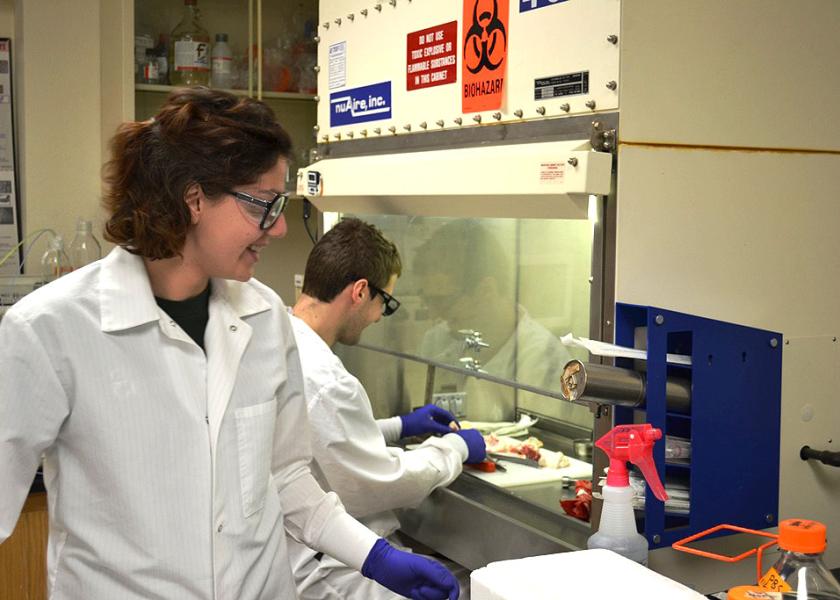University of Wyoming Seeks Better Brucellosis Control though Vaccine Development, Vaccination Practices

Scientists at the University of Wyoming are hopeful their brucellosis studies may produce a better vaccine for livestock and are studying whether a change in vaccination procedures could offer better control.
Brucellosis can cause elk, bison and cattle to abort fetuses. The highest risk of brucellosis transmission to other animals occurs after an animal has an abortion. The organism can also be transmitted to humans, often through consumption of unpasteurized milk or dairy products such as soft cheese, which may result in a severe disease called undulant fever.
Brucellosis is an exotic disease that came from Europe and European cattle and was then transmitted to wildlife in the U.S., establishing the reservoir in elk and bison seen in the Greater Yellowstone Area.
“We have eradicated the disease from livestock but occasionally get a disease spillover from elk transmitting the organism to livestock,” said Bruce Hoar, University of Wyoming brucellosis research coordinator. “One of the ways we try to control brucellosis is through the use of vaccinations.”
Scientists are interested in pursuing vaccines for wildlife, particularly elk; existing vaccines for cattle are not very effective at preventing disease in elk. The emphasis, though, is on livestock vaccines, said Hoar.
Cattle in the U.S. have been vaccinated since the 1930s with a vaccine called Strain 19. That vaccine was moderately effective preventing 60-70 percent of cattle from aborting after becoming infected, said Hoar. Strain 19 was replaced by a vaccine called RB51 in the 1990s and is the currently licensed vaccine for cattle.
“It, too, only protects 60-70 percent of animals in the herd, so that leaves 30-40 percent of the herd vulnerable, and, because of that, we are looking for better vaccines, and that is what a team of researchers here at the University of Wyoming have been involved in for a number of years,” said Hoar.
Several investigators at UW are looking at different vaccines. Gerry Andrews, associate professor in the Department of Veterinary Sciences and a medical microbiologist, has developed unique vaccines.
“These vaccines have been tested in the mouse model of brucellosis,” said Hoar. “They are in the early stages of development, but we are very excited and hopeful this will lead to a better vaccine for cattle.”
Another, more recent, effort is to simply vaccinate with more doses of RB51 vaccine,said assistant professor Jeff Adamovicz in the department.
“We recently completed a vaccine study in Black Angus cattle and have promising results that show multiple doses of RB51 vaccine reduced abortions in cattle and may also reduce the risk of transmission,” said Adamovicz. “We hope to pursue a recommendation to change the vaccination practices in Wyoming based on our findings.”
Other efforts to model the risk of brucellosis transmission and development of economically feasible ranching practices are also of interest.
These efforts parallel vaccine development efforts but are an important part of the overall goal of reducing transmission and economic impacts to Wyoming ranchers, according to Brant Schumaker, an assistant professor in the Department of Veterinary Sciences, and Dannele Peck, associate professor in the Department Agricultural and Applied Economics, at UW.
Other on-going efforts to break disease transmission are also important, said Hoar. These include the work of the Wyoming Game and Fish Department, a crucial partner in the effort to control the disease, he said. Elk calves on the feeding grounds are still vaccinated with Strain 19.
Game and fish department personnel are able to vaccinate the elk with a “bio bullet,” which contains a freeze-dried vaccine pellet. The bullet is shot into a rear muscle of the animal and then breaks down, slowly releasing the vaccine into the animal. That technique works well but in a non-feeding ground elk population, the process becomes more challenging, said Hoar.
In northwestern Wyoming, 20-40 percent of elk will test positive on a blood test, which means they were at some point exposed to the bacterium. That doesn’t necessarily mean they are actively spreading the organism, said Hoar.
As one goes east of Yellowstone National Park into Park County, 5-15 percent of elk can be seropositive, which shows they have beenexposed to the disease and that brucellosis has spread farther east. Most recently, seropositive elk have been found in Big Horn County raising concerns about the spread to local cattle, although no seropositive cattle have beenfound in this area, said Hoar.
“It is still a concern, because we are seeing it where we historically haven’t been seeing it in our elk,” said Hoar.
The most recent farm bill approved use of funds for brucellosis vaccine research.
“There could be significant funding for brucellosis vaccine research, and that would be a really good thing,” said Hoar. “The University of Wyoming would be a great competitor for these grant funds, as we already have a well-qualified team in place that can perform the research. Our long-term goal is to develop vaccines, vaccine strategies and diagnostic tests that will enhance our ability to control the potentially devastating effects that this disease could cause to Wyoming cattle and wildlife.”
Source: University of Wyoming







